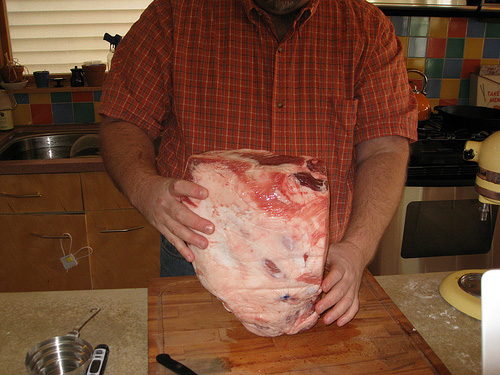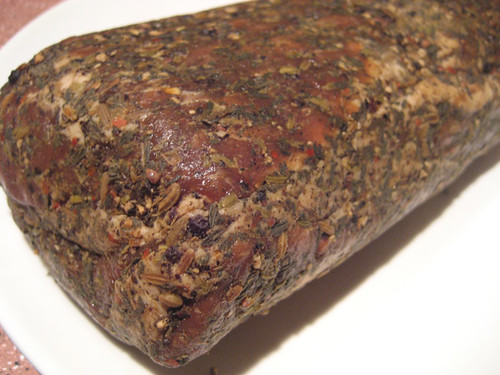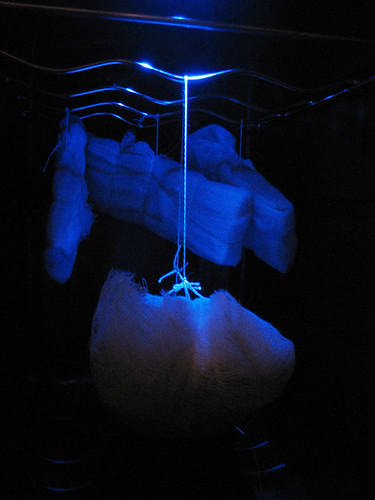
Me, pork shoulder. Photo by David Hammond.
The story so far: David Hammond bought his wife one of the mulefoot pigs featured in the “There Will Be Pork” podcasts. He agreed to let me try to make coppa out of part of the shoulders, and I also agreed to make him bacon. Here’s Hammond’s account of the first step of that process, with pictures of me cutting out the coppa muscle and salting/spicing it for a couple of weeks of curing in the fridge.
I was rather proud of the process of removing the coppa muscle. (Think of it as sort of a roll of meat, running roughly parallel to the spine on the shoulder.) Every time I’ve had any interaction with a pork shoulder lately, I’ve poked and prodded it to try to figure this out, and had some guidance from both Nathan Sears at Vie and especially Rob Levitt at Mado, who let me photograph it step by step. Still, I can’t say I was sure where it was…
Then we unwrapped David’s mulefoot shoulder and… hey! There it was, a perfect little cylinder of meat tucked in next to the blade. (If you look at the picture with the laptop in it, look at the end of the shoulder nearest the edge of the computer, and you’ll see an area where it’s sort of round on one end, and then you see meat and fat running long and straight along the body of the shoulder. That’s the cylindrical coppa, basically.)
I’m starting to think, actually, that when you get something that’s been naturally raised, you’re more likely to find its parts in the proper places and proportions, like on the charts, and it’s only when you get meat that’s been raised by some more artificial process that it seems kind of jumbled, irregular, like way too thin bellies or pork shoulders that each look like some different jumble of hunks of meat. So it was really a breeze cutting the coppa out to produce a nice little roll of meat and, just as importantly, a remainder of the shoulder that wasn’t mangled and abused and would make a nice barbecued pork shoulder, as it did. [Note: Rob Levitt has a more prosaic theory: it was simply butchered with a lot more skill than the stuff that gets hacked and shipped to Peoria or wherever. Still, I think there’s something to the idea that better raised meat is better proportioned, neater, more like it should be than something that was grown unnaturally quickly.]
* * *
So it’s a little over two weeks later and time to hang and dry the coppa. Here’s how it looked when it came out of the plastic bag in the fridge, like a Stuckey’s pecan roll’s fantasy of transcendence:

30 minutes of rinsing the salt off (that was Rob Levitt’s advice) and then wrapped in cheesecloth and tied off (if Ariane of Top Chef needs any tips on how to tie up meat, have her call me). Rob recommends cheesecloth as opposed to some kind of casing because you can remove it if it gets bad mold, wash the meat, and replace it. I also liked the fact that I didn’t have to buy 100 feet of it at a cost of about $30 plus shipping, as was the case with the 65mm casing.

Then hang it in my wine fridge— that’s the lardo hanging above it— and wait a month or so.



 If you like this post and would like to receive updates from this blog, please subscribe our feed.
If you like this post and would like to receive updates from this blog, please subscribe our feed.




